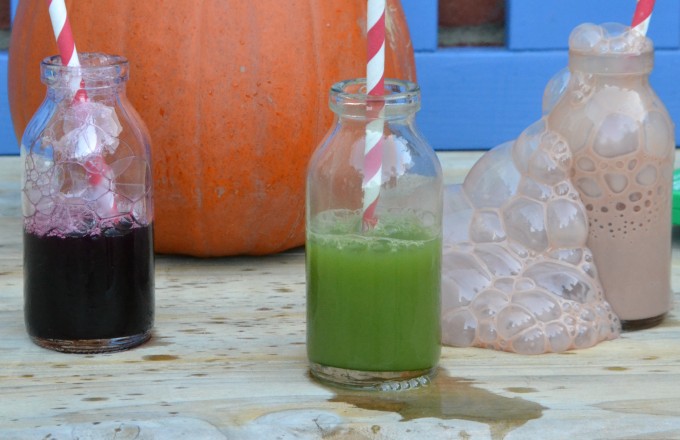Like most children, if given a straw my four will blow bubbles till the cup overflows, which gave me an idea for a fun investigation. We tried to find out which of three different drinks made the best bubbles, using it as a fun exercise in experimental design.
Bubbly Drinks Challenge
Find out whether purple grape juice, apple juice or chocolate milk make the most bubbles when you blow into them with a straw.
Things to think about
What will you change?
- The drinks
What will you keep the same?
- The type of straw
- The length of time you blow into the drink
- The amount of drink
- The same container for each drink
- Person blowing – why do we have to think about this?
Method
- Measure the same amount of each drink into each container
- Blow into each for a set period of time, we chose 10 seconds
- Observe the bubbles
Results
We found the milk bubbled up the most, and the juice bubbles popped sooner. Can you think why this might be?
It’s most likely to do with surface tension.
Milk contains long, string-like molecules of protein that reduce the surface tension of the bubble, making the bubbles last longer. Simple water molecules stick to each other strongly, they have a high surface tension so the bubbles pop quickly when they are stretched out.
What improvements would you make to your design?
We test plain water as well, and maybe a fizzy drink.
Extension activities
What happens if you use different containers or a wider/thinner straw?
Could you compare low fat with full fat milk? How would the fat affect surface tension?
What if the milk was warm?
More science for kids
I’ve got lots more spooky science experiments and Halloween STEM challenges you might like too!

This activity is great for
Learning Objectives – Key Stage 1 – Science
- asking simple questions and recognising that they can be answered in different ways
- observing closely, using simple equipment
- performing simple tests
- using their observations and ideas to suggest answers to questions
- gathering and recording data to help in answering questions
Working Scientifically – Key Stage 2 – Science
- asking relevant questions and using different types of scientific enquiries to answer them
- setting up simple practical enquiries, comparative and fair tests
- making systematic and careful observations a
- gathering, recording and presenting data
- reporting on findings from enquiries
- using results to draw simple conclusions, suggest improvements and raise further questions
- using straightforward scientific evidence to answer questions or to support their findings.

Last Updated on September 11, 2020 by Emma Vanstone



My son will love this experiment. He likes to blow bubbles in his milk. He’ll be thrilled to incorporate it into a science experiment. 🙂